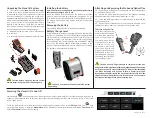
Do not attempt to remove or replace the limit stickers on this instrument. If the manifold pressure limits
for your engine do not match those which are marked on this instrument send this unit back to Electronics
International Inc. for recalibration. DO NOT install or use a primary engine instrument that is not prop-
erly calibrated for your aircraft.
7. Before starting the installation make sure the unit will fit in the location you intend to install it without
obstructing the operation of any controls.
8. If this instrument is to replace an existing unit in the aircraft, it is the installer's responsibility to move or
replace any existing instruments or components in accordance with FAA approved methods and proce-
dures. The following Installation Instructions do not cover moving or the removal of any existing instru-
ments or components.
Route The Circular Connector:
Route The Circular Connector:
Route The Circular Connector:
Route The Circular Connector:
Route The Circular Connector:
Starting from under the instrument panel, route the circular connector wire harness up to the instrument
mounting location. (See the wiring diagram at the back of this manual). Place the circular connector about 8
inches back from the panel. Tie wrap the harness in place approximately 1 foot back from the circular connector.
This will allow the harness to be flexible and accomodate varying lengths in instrument wires. Be sure these
Be sure these
Be sure these
Be sure these
Be sure these
wires do not obstruct the freedom of travel of any controls.
wires do not obstruct the freedom of travel of any controls.
wires do not obstruct the freedom of travel of any controls.
wires do not obstruct the freedom of travel of any controls.
wires do not obstruct the freedom of travel of any controls.
Route the Power and Ground Wires:
Route the Power and Ground Wires:
Route the Power and Ground Wires:
Route the Power and Ground Wires:
Route the Power and Ground Wires:
Route the red wire in the harness to the aircraft’s 12 or 24 volt main or emergency bus as applicable via an
independent circuit breaker (five amps or less). An alternate method would be to route the red lead to the bus via
a one amp in-line fuse. With this method a spare fuse should be kept in the aircraft.
Route the black wire in the harness to a good ground . Tie wrap these wires so they do not obstruct the
Tie wrap these wires so they do not obstruct the
Tie wrap these wires so they do not obstruct the
Tie wrap these wires so they do not obstruct the
Tie wrap these wires so they do not obstruct the
freedom of travel of any controls.
freedom of travel of any controls.
freedom of travel of any controls.
freedom of travel of any controls.
freedom of travel of any controls.
Route the Backlight Wires:
Route the Backlight Wires:
Route the Backlight Wires:
Route the Backlight Wires:
Route the Backlight Wires:
Connect the backlight wires as follows:
1. It is recommended to permanently power up the digital display backlight.
a) For a 12-volt system connect the white/brown wire to the instrument Red Power Lead. Con-
nect the white/red wire to ground (see Wiring Diagram).
b) For a 24-volt system leave the white/brown open. Connect the white/red wire to the instrument
Red Power Lead (see Wiring Diagram).
2. Connect the white/orange wire to the panel light rheostat. This wire will dim the analog LED’s for
night operation when the panel lights are turned on. If this line is left open, the analog LED's will
remain at full intensity at all times. Also, if the voltage on this line drops below 11.5 volts, the analog
LED's will be displayed at full intensity. Tie wrap all wires so they do not obstruct the freedom of
Tie wrap all wires so they do not obstruct the freedom of
Tie wrap all wires so they do not obstruct the freedom of
Tie wrap all wires so they do not obstruct the freedom of
Tie wrap all wires so they do not obstruct the freedom of
travel of any controls.
travel of any controls.
travel of any controls.
travel of any controls.
travel of any controls.
5
Rev. C: 9/30/97
































